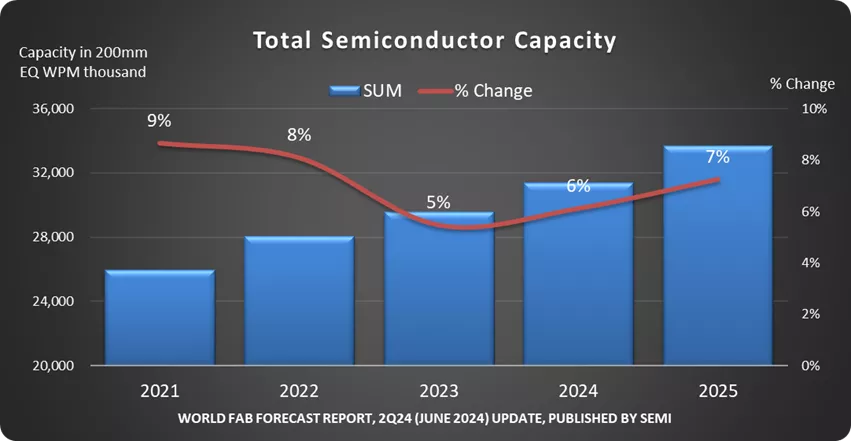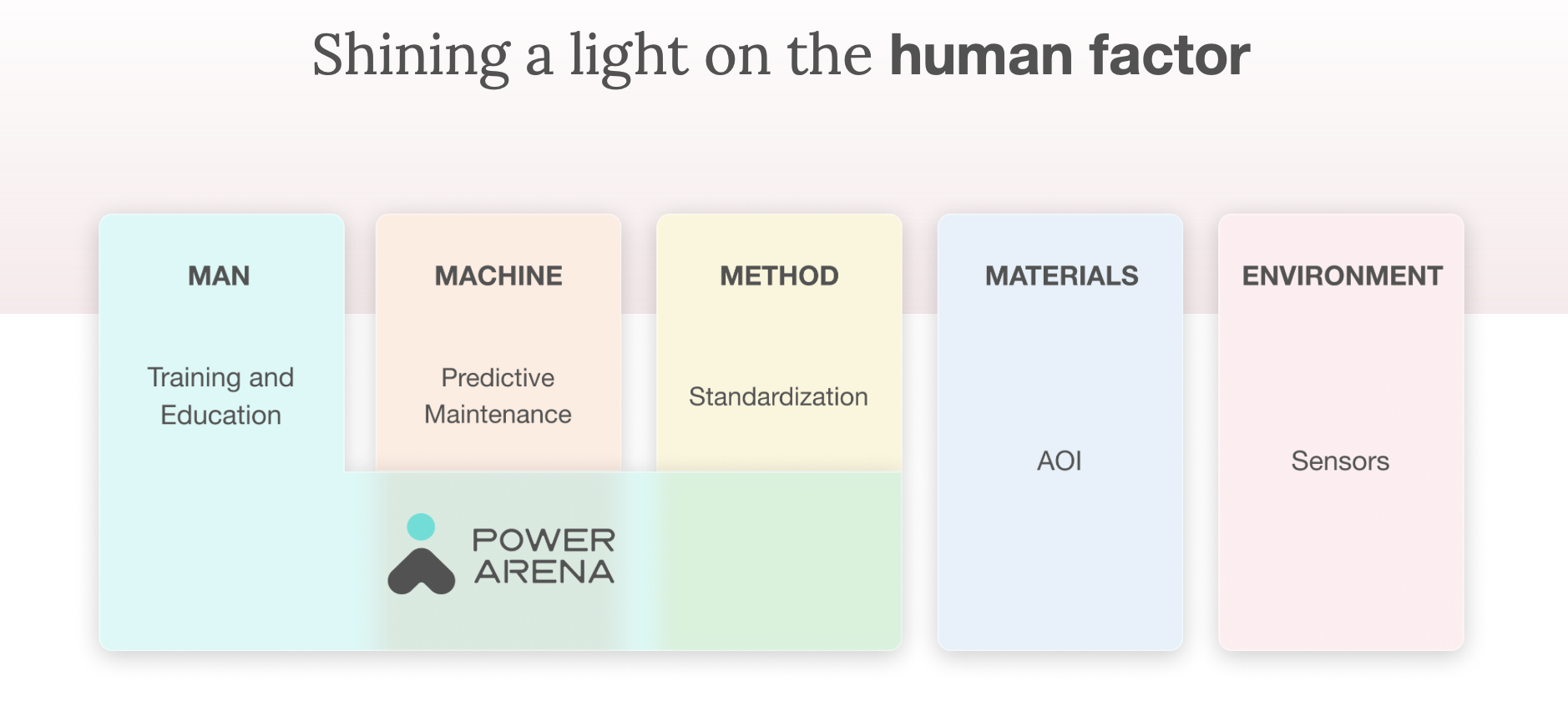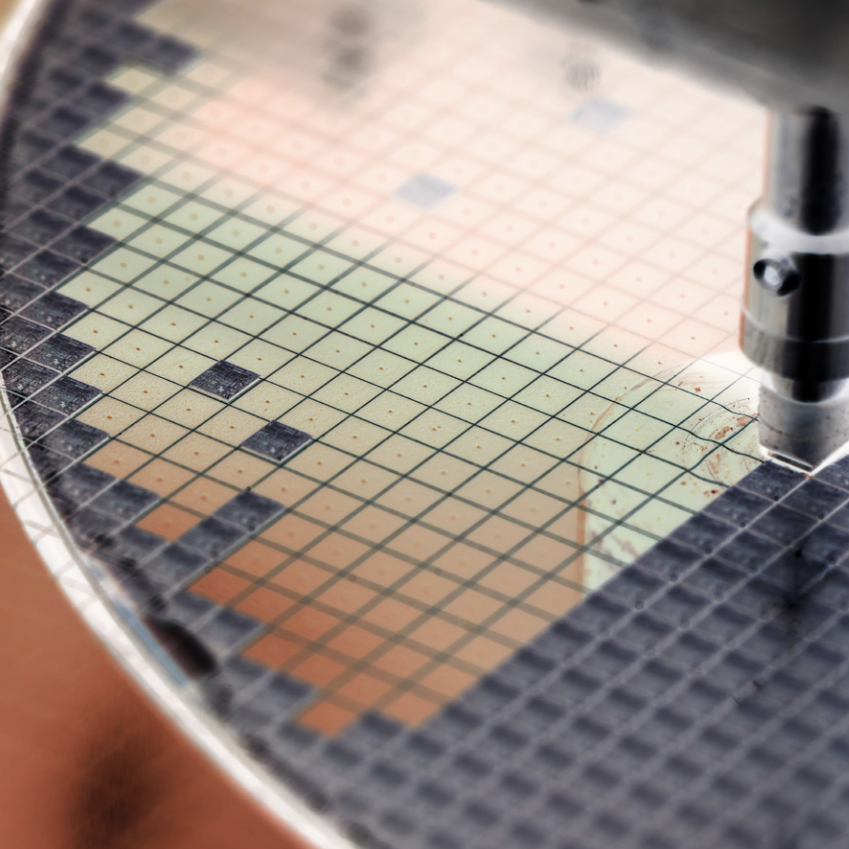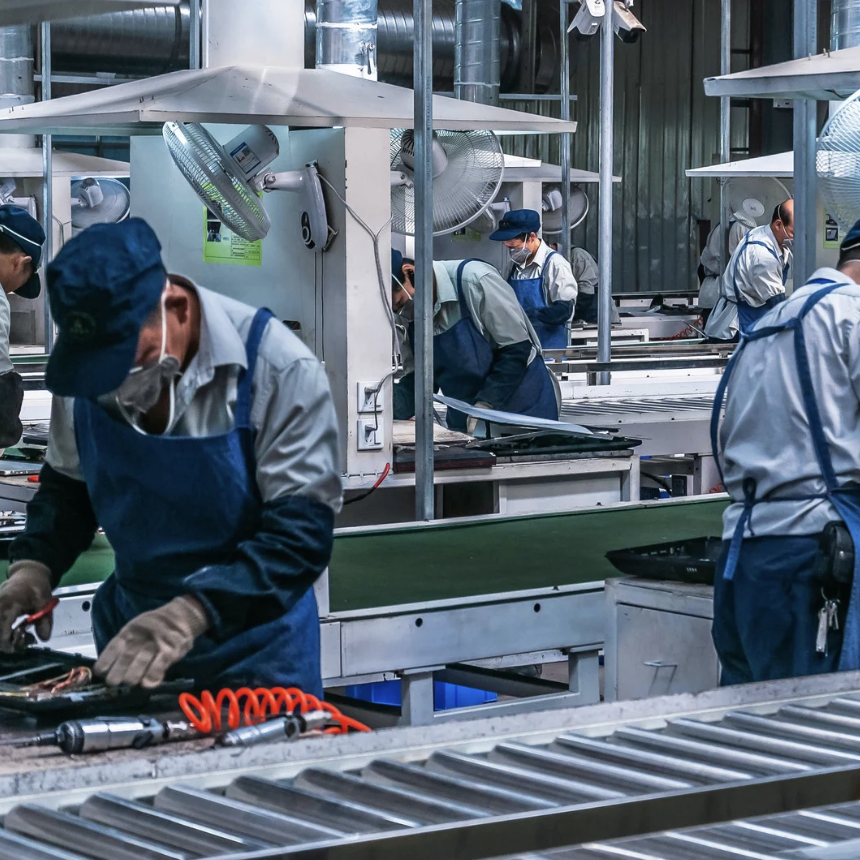By Sursha Wu
Introduction
Global semiconductor market size was valued at USD 611.35 billion in 2023 and is projected to grow from USD 681.05 billion in 2024 to USD 2062.59 billion by 2032, exhibiting a CAGR of 14.9% during the forecast period (2024-2032).
Source: Fortune Business Insights, December 02, 2024

The network and communication sector, driven by demand for smartphones, smart devices, and 5G technology, dominates the global semiconductor market with a 32% share. Source: Fortune Business Insights, December 02, 2024

The network and communication sector holds similar market shares in China (32.2%) and globally (32%), which highlights its significance and impact on the semiconductor industry. Source: Fortune Business Insights, December 02, 2024
Driven by growing market demand, the global semiconductor industry continues to expand its production capacity.
Global semiconductor manufacturing industry is expected to increase capacity by 6% in 2024 and post a 7% gain in 2025, reaching a record capacity high of 33.7 million wafers per month (wpm: 8-inch equivalent)
Source: Semi, World Fab Forecast, June 18, 2024

Semiconductor Capacity Development Forecast。Source: World Fab Forecast
Despite continuous capacity increase, supply is still lower than demand.
Unger this context, improving yield has become a key competitive factor for manufacturers. Achieving high yields reduces waste and enables limited capacity to produce more qualified products, meeting the strict quality requirements of high-end applications.
Yield reflects the proportion of high-quality products produced. It directly impacts manufacturing costs and customer satisfaction, which in turn influences order acquisition and market share growth.
Focusing on AI vision technology in smart manufacturing, PowerArena takes a long-term strategic approach to assist semiconductor companies in achieving automated production management. We help manufacturers create efficient production lines that achieve high yield rates and first pass yield (FPY), enhancing their market competitiveness.
Challenges in Yield Optimization for Semiconductor Manufacturing
Improving yield is a major challenge for the semiconductor industry.
Complex manufacturing processes involve numerous variables, where even minor deviations can significantly impact yield.
As new technologies emerge, stabilizing and improving yield while innovating has become key to staying competitive.
Yield optimization means that manufacturers improve processes for producing more high-quality products while reducing waste and defects.
Process Complexity
Producing process of semiconductors can include hundreds or even thousands of steps. The accumulation of minor deviations at each step can lead to ultimate significant defects. Additionally, interactions between factors like heat, stress, electricity, or materials like silicon, copper, and dielectric layers, make it harder to fix the problems.
As process nodes shrink, even the smallest errors can reduce product quality. Additionally, the process is highly sensitive to environmental factors, such as airborne particles and changes in temperature and humidity.
At the same time, diagnosing issues in large volumes of data is difficult. It often requires significant time and resources to identify the root cause.
Big Impacts from Small Defects
From the perspective of 4M1E in manufacturing (Man, Machine, Material, Method, Environment), fluctuations in any factor can influence yield:
Man: Differences in operators’ skill levels or work habits can cause product defects or disrupt production.
Machine: Equipment is crucial in semiconductor manufacturing, but poor maintenance can compromise precision and stability and therefore affecting quality.
Material: Minor differences in material batches can lead to defects that reduce yield.
Method: Improper process parameter settings or poorly designed standard operating procedures (SOPs) can directly impact chip performance and stability.
Environment: Tiny environmental changes, such as static electricity or contamination, can damage wafers.

PowerArena focuses on “Man”, “Machine”, and “Method” to improve and optimize producing production process.
AI in Semiconductor: Managing Manual Operations
Humans are the most challenging factor to track in semiconductor manufacturing.
While semiconductor production heavily relies on automated equipment, tasks requiring flexibility often depend on operators.
However, operators’ assembly actions and production behaviors on the line lack effective systems for automatic recording and analysis which leads to management blind spots.
By introducing AI into semiconductor processes, PowerArena eliminates the data gap in manual operations and enhances management efficiency.
Tracking Critical Process Data to Accelerate Optimization
Machine operation data is tracked by IoT systems.
However, manual assembly workstations rely on management to manually observe and collect production data.
A common example is cycle time, a key metric for measuring production efficiency. To obtain this data, industrial engineers must physically observe the production line, use a stopwatch to record cycle times, and then manually write down the data.
This limited data collection fails to reflect complete and accurate operations, and manual recordings are often unreliable.
Integrating AI vision into manual production lines enables comprehensive recording and analysis of operators’ production processes.
Management can first define operational standards, such as the start and end of production scenarios. AI vision then tracks key production line data. Once the production goals are set, the system can automatically monitor cycle time, process time, and idle time.
Only complete and accurate process data can serve as the foundation for optimizing production plans.
Real-Time Error Alerts to Prevent Mistakes
In the semiconductor industry, there is little room for error. Even small mistakes made by operators can significantly impact product yield.
PowerArena HOP (Human Operation Platform) functions as an experienced manager, helping to eliminate human errors within production processes.
With predefined SOPs, the system monitors operator actions. When it detects deviations from the standards, it sends real-time alerts to the production team or line engineers and shows the cause of the error. Managers can immediately review production footage to pinpoint the root cause and decide whether to stop the production or allow the process to continue.
Without modifying existing production workflows, HOP enables management to capture more details of the production process. It not only prevents errors at the process stage but also provides a clear and complete view of production through an automated system.
Maintaining 95% Yield in Key Workstation by HOP:
AI is rapidly reshaping global industries, and the speed of AI adoption determines a company’s competitiveness.
By implementing AI vision technology on semiconductor production lines, PowerArena delivers practical benefits with actionable AI solutions.
PowerArena HOP has successfully helped manufacturers maintain a consistent 95% yield rate in the specific workstation.
Through AI vision, the platform automatically detects potential assembly errors, such as missing components. HOP allows managers to monitor production in real-time, correct mistakes immediately, and reduce rework and waste.
Additionally, HOP bridges the data gap in manual operations, giving management better visibility into operator activities. This helps optimize workflows and allows teams to focus on strategies that further improve yield.





